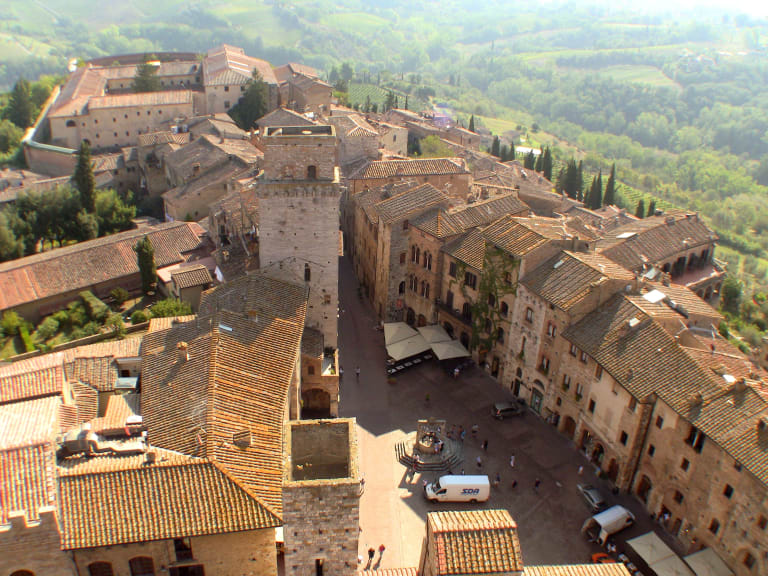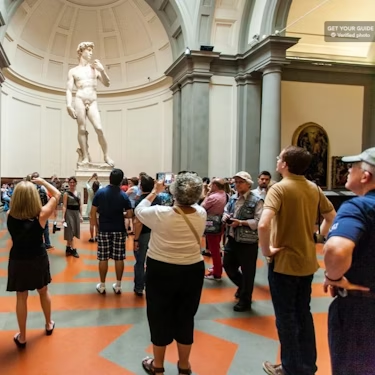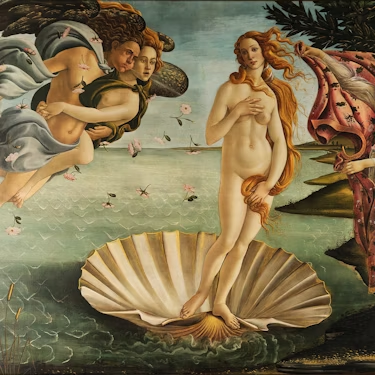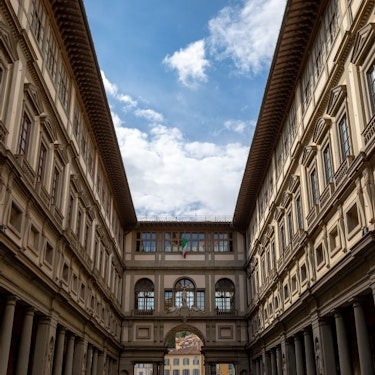More about: 10 Things to Do in Florence in March
For its history and art, Florence is undoubtedly one of those destinations that you have to visit at least once in your life no matter when you travel. Its stupendous Cathedral, the magnificent Ponte Vecchio, its gastronomy or its museums are enough to spend a few days in the capital of Tuscany.
In March, moreover, the weather begins to improve, but there has not yet been a massive arrival of tourists. This month, which marks the end of winter and the beginning of spring, the city celebrates this change with various festivals and activities.
1. Try a zeppole on St. Giuseppe's Day

Like the rest of Italy, Florence celebrates San Giuseppe's Day (Father's Day) on March 19. The most typical thing to try is zeppole, whose recipe was born in Naples and you can learn it if you book an Italian cooking class in Florence. It is a ring of fried dough filled with pastry cream that can also be baked and served with honey, cinnamon and vanilla.
It is said that the celebration began in Sicily in the Middle Ages, when citizens begged San Giuseppe to end the plague in exchange for commemorating the day by leaving large amounts of food on his altar. That is why, if you go to the Church of San Giuseppea you can see how some Florentines leave on the altar all kinds of food to be distributed among the needy.
Another typical tradition of this day is for parents to receive a gift from their children. If you have gone to Florence with children it can be a good occasion for them to entertain themselves looking for some detail.
2. Say goodbye to the Florentine year on March 25th.

You don't have to go to Florence in December to enjoy the festivities to welcome the new year. On March 25, Annunciation Day, the so-called Florentine New Year's Eve is celebrated with various festivities and parades. The history of this feast comes from the time when there was no unified civil calendar and Florence celebrated the change of the year coinciding with the religious feast of the Annunciation of Mary.
In 1582, Pope Gregory XIII approved the Gregorian calendar and demanded that all peoples adopt it, with January 1 as the first day of the year. Leon X, one of the Florentine popes of the Medici family, later insisted that this be done to favor trade. Florence ignored this mandate for a long time and continued to celebrate New Year's Day in March.
It was not until 1750 that it was forced to change its calendar, something that is recalled in a marble inscription located in the piazza della Signoria, which you can see if you book a ticket to the Uffizi Gallery to enjoy the best paintings of the Uffizi Gallery. Even so, Florence did not give up its tradition and, today, a large fair is held in Piazza Santissima Annunziata and a historical parade.
3. Don't hold back at the Chocolate Fair

We already know that excesses are not good, especially when it comes to sweets. However, if your stay in Florence coincides with the Chocolate Fair, the only thing you can do is enjoy this delicacy.
Although it does not have a fixed date, it is usually held in the first days of March and you can see real master chocolatiers making their products, as well as taste the different varieties offered in the stalls that are placed in Piazza Santa Croce.
An ideal plan after enjoying a guided tour of Santa Croce, a place through which many guided tours of Florence usually pass.
4. Visit the best museums before the crowds arrive

The weather in the capital of Tuscany during the month of March begins to warm up, although it can still be quite cold. In addition, although there will always be tourists, it can be said that it is the last month in which you will not find large crowds. Both reasons make these dates the perfect time to visit the best museums in Florence.
Not only will you escape the cold temperatures outside, but you will be able to admire Michelangelo's David and other works of the Accademia if you book a visit to the Accademia Gallery, see the inside of the Pitti Palace or hire a guided tour of the Uffizi Gallery in a quieter way and without being pushed around.
In addition, although it is not known if the initiative will continue in the coming years, the state museums established the so-called Museum Week, a few days when you could enter for free.
5. Enjoy the best Italian food in Fuori di Taste

March is also the month when Florence's most important gastronomic event takes place: Fuori di Taste, organized by Pitti Taste at Stazione Leopolda. Although part of the facilities are intended for professionals, the general public can also come to taste and learn about the best culinary developments.
At this fair you will find dishes from all over the Italian peninsula. If you compare them with those shown in the various gastronomic tours of Florence, you will see the differences that exist in each region and that its richness in this subject goes beyond pasta and pizza.
Still, if you are passionate about both products, the most typical of Italy, be sure to book a pizza and gelato cooking class in Florence.
6. Discover Dante's places in his day

Italy has declared March 25 with the National Day of Dante Aligheri. I propose you to make a small route through several of the places associated with this great writer. After all, Florence was his city of birth and where he lived until he had to go into exile in 1302.
The choice of this date is not accidental, since it is the day on which the famous journey of his most important work begins: The Divine Comedy. For the tour I suggest you can walk or take advantage of one of the tour buses in Florence.
- Basilica Santa Maria Novella: Dante attended the Studium, at that time one of the most important centers of theology and philosophy studies on the continent. In the Chapel of the Spaniards you can see a portrait of the poet.
- Bargello Museum: in Dante's time it was a building dedicated to administration. It was in its halls that the poet was sentenced to exile.
- Church of the Holy Apostles: according to some scholars, the atmosphere of this temple inspired Dante's vision of Limbo.
- Palazzo Vecchio: in the PalazzoVecchio, which Dante could not see completely built, is the writer's funerary mask.
- Badia Fiorentina: this beautiful building is a fundamental part of the poet's life. According to legend, it was here that he met his beloved Beatrice, who became his muse.
- Dantesque Quarter: characterized by narrow streets and tower houses, many claim that Dante lived in the area and, in fact, in the nineteenth century the House of Dante, which houses a museum about the poet, was built here. In the neighborhood were also placed 33 of the so-called Dantesque tombstones in order not to forget the link of Dante with the neighborhood and to remember the characters of his work.
- Church of Santa Margherita Cerchi: it houses the tomb of Beatrice.
- Piazza del Duomo: among the many things to see in Piazza del Du omo is the Baptistery of St. John, where the poet was baptized and which is named in his canticle of the Inferno.
- Abbey of San Miniato al Monte: crossing the Ponte alle Grazie you reach the steep staircase of the Via Crucis on the way to the abbey. Dante compared the ascent to the Mountain of Purgatory in the Divina Commedia.
7. Celebrate the arrival of spring in the fantastic gardens of Florence

As March progresses and spring approaches, Florence's weather gradually warms up and makes its presence felt in the fabulous gardens, making it a great month for strolling. Florentines themselves begin to fill the parks and sometimes some cultural activities are held in them.
- Boboli Gardens: part of the history of the Medici and therefore of Florence. It can be accessed from the Pitti Palace itself and is one of the only ones in the city where an entrance fee is required. From the highest parts you will have beautiful views. Strolling along its paths you will find statues, caves, fountains and beautiful vegetation.
- Villa il Ventaglio Park: being located on one of the hills in the northeastern part of Florence, this garden is one of the least visited by tourists. Built in the 16th century, it was conceived to resemble English gardens, with a pond, lawns, a wood and paths ascending to the top of the hill.
- Le Cascine Park: considered the most important green area in a city that does not have too many, Le Cascine stretches along one of the banks of the Arno River, north of the historic center. It was originally intended to serve as a hunting ground for the Medici family. Inside you can see a velodrome, an amphitheater, kiosks where you can buy drinks, fountains and even some small Renaissance palaces.
- Rose Garden: this is possibly the best known of Florence's gardens. It is located very close to Piazzale Michelangelo and offers unbeatable views. As its name indicates, the main attraction is its roses, although it also houses many other varieties of plants.
8. Come to San Gimignano to experience the Santa Fina festivities.

Taking an excursion from Florence is something you can consider if you are going to be in the city for several days. The offer is quite wide, whether you want to hire an organized tour or if you prefer to move on your own. One of the best excursions from the city that you can make in March is to San Gimignano, especially if you make it coincide with the feast of Santa Fina, its patron saint.
The big day of this feast is March 12, when the 14 medieval towers of the town are adorned with white violets in honor of Santa Fina. In addition to the religious significance, the celebration is also a welcome to the resurgence of life in spring, when the fields and vineyards produce their fruits again.
In the town squares there are several stalls selling handicrafts and food, in addition to the fantastic wine of the Vernaccia appellation of origin. As if the attraction of the festival were not enough, San Gimignano is considered one of the most beautiful villages in all of Italy and was declared a UNESCO World Heritage Site.
How to get there from Florence
- Organized excursion: without a doubt, booking an excursion to San Gimignano is the best way to get there from Florence. Excursions often visit other interesting villages in the area.
- Bus: the bus will require you to change buses. To start with, you will have to go to the Busitalia SITA Nord station, next to the Santa Maria Novella train station. I recommend you check the timetables, but they usually leave every 30 minutes in the direction of Poggibonsi. Here you will have to take another bus that leaves you five minutes from the old town of San Gimignano.
- Car: if you have a car, the route is quite easy and you will reach the town in just one hour.
9. Don't miss the Scoppio del carro, one of the most curious traditions of the town

If Easter Sunday falls in March you will be able to witness one of the most curious traditions: the Scoppio del Carro or Explosion of the Cart, an event that dates back to the first crusade undertaken by European Christians to try to conquer Jerusalem in 1099. When the crusaders achieved their goal and, as a celebration, the Florentine Pazzino de'Pazzi climbed the walls to place a white and crimson flag. As a gift for that gesture he received three stones from the Holy Sepulchre.
When Pazzi returned to Florence he placed the relics in his palace, but later they were moved to the Church of the Holy Apostles, where they can still be seen. And since then, on Easter Sunday a fire was lit with the stones in front of the Cathedral of Santa Maria dei Fiore, and young people came to the site with torches. The actual celebration begins at about 10 a.m. in the Church of the Holy Apostles. There, a candle is lit using the Pazzi stones and a procession to the Cathedral begins.
At the same time, an ox-drawn carriage leaves Piazza Porta al Prato with the same destination. The carriage travels accompanied by 150 soldiers, musicians and representatives of the historical calcium. Once the carriage reaches the door of the Cathedral, it is joined by an iron cable to a column in the center of the choir of the temple. Through this cable will go the Colombina, a kind of rocket that sets fire to the chariot. Right after, a great fireworks show begins.
10. Live St. Patrick's Day: a little bit of Ireland in Florence

Although not an Italian holiday, Florence celebrates St. Patrick's Day in a very prominent way. If you are in town on March 17, don't hesitate to wear green and join in the 3-day events in Florence. Festivities, special events and concerts where there is no shortage of food and Irish beer.
One of the most interesting events is the Irish Festival at the Tuscany Hall Theater, where you can attend Celtic music and dance performances. And as with any St. Patrick's Day celebration worthy of the name, the center of the party is in the Irish pubs. Florence is home to more than twenty, although some are more authentic than others.
My recommendation is that if you want to feel like you are spending a few hours in Dublin during your stay in Florence and, of course, taste a good Guinness you go for:
Weather in Florence in March

The weather in Florence is starting to recover from the winter cold, although not yet mild. The temperature is cool, with an average high of 16°C and a low of 5°C.
As for rainfall, March is a rather unstable month. Although it is not the heaviest rainfall period of the year, occasional heavy showers can occur, especially in the evenings.
Is March a good month to visit Florence?

Few cities in the world offer as many places to see as Florence. Although there are opinions to suit all tastes, I personally believe that March is one of the best months to visit the city. For starters, it's not as cold as January and February, and the daylight hours start to lengthen as the month progresses.
However, the city still experiences a certain tranquility regarding the influx of tourists. Unlike the high season, you will be able to enter its museums, cathedrals and churches with a certain calmness, something impossible in summer.




